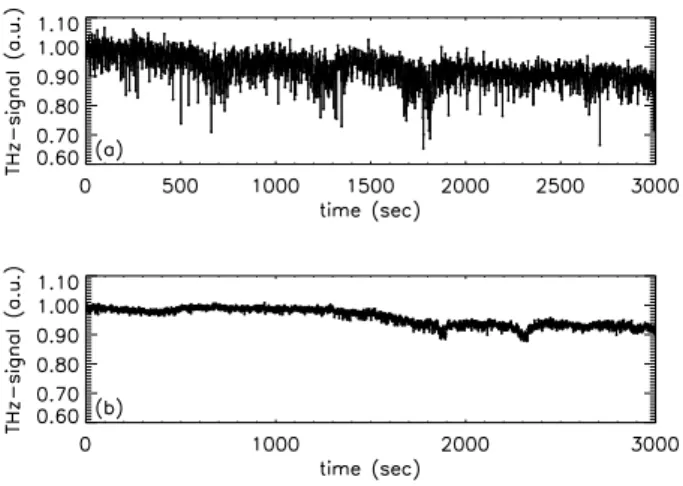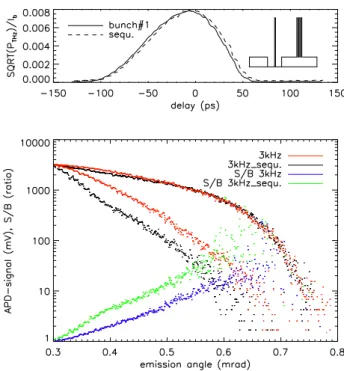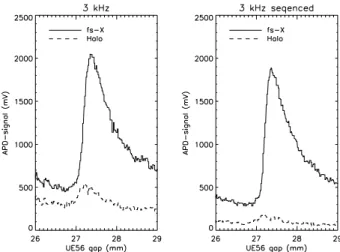FEMTOSLICING AT BESSY–DETECTING MORE PHOTONS
∗T. Quast
†, K. Holldack, BESSY, 12489 Berlin, Germany S. Khan, Institut f¨ur Experimentalphysik, 22761 Hamburg, Germany,
R. Mitzner, Physikalisches Institut der Universit¨at M¨unster, 48149 M¨unster, Germany
Abstract
The BESSY femtoslicing facility is now under routine operation as a unique source for 100 fs x-rays in the range of 400 to 1400 eV with linear and circular polarization. In order to overcome inherent flux limits given by the fem- toslicing principle several attempts have been made to in- crease the flux and the stability of fs x-rays at the user ex- periment. We present the improved stability of the source after installing a new laser beamline. Increased flux due to operation at 3 kHz reprate is now accompanied by a re- duced ps background employing a novel sequenced syn- chronization method. Further efficency is achieved by a new high flux beamline (x-ray zone plates) and by parallel detection of fs x-ray spectra. The effect of a dedicated new radiator will be discussed.
INTRODUCTION
The BESSY femtoslicing facility is now well established [1] and has proven its successful routine operation as a user facility for fs [4] and ps [2] laser pump – x-ray probe exper- iments . Obviously, the inherent low photon flux (compared to regular x-ray beamlines) is the most restricting element of all femtoslicing sources.1In fact, the flux reduction lim- its the accessibility to many standard x-ray techniques like photoemission, fluorescence detection, soft x-ray scatter- ing or reflection. We follow three different tracks to im- prove femtoslicing in that direction: (i) increasing the flux from the emitting source, (ii) improving the beamline trans- mission and (iii) developing detection sytems of higher ef- ficiency. Here we will discuss several improvements at the BESSY femtoslicing source either being already imple- mented, under preparation or still in the phase of planning.
NEW LASER BEAMLINE
A new beamline that feeds the laser into the modulator was installed in the last shutdown. To avoid damage of the mirrors due to high laser intensities, the distance of the last mirror to the interacting modulator was enlarged. The new beampath is kept completely under vacuum and comprises a 3” motorized lens telescope and motorized mirrors. Each mirror-surface is monitored with a CCD-camera to control
∗Work supported by the Bundesminister f¨ur Bildung und Forschung and by the Land Berlin
†quast@bessy.de
1Currently there are three femtoslicing sources under operation: at the ALS (Advanced Light Source), at the SLS (Swiss Light Source) and at BESSY (Berliner Elektronenspeicherring).
the laser-alignment and to check for possible damage of the reflective coating. With the new beampath, system- atic drifts of the laser position with respect to the electron beam disappeared. Furthermore, short time fluctuations are strongly reduced. Fig. 1 compares the stability of the old and the new beamline over a time span of 50 minutes as monitored by means of the THz signal, which indicates the energy modulation. The improved short term stability can be assigned to unsufficient shielding against air turbulence in the previous beamline that was not under vacuum. The residual stability on a long term scale is mainly due to cor- rections by a longitudinal feedback correcting for shifts of the synchronous phase with decaying bunch current.
Figure 1: Comparison of the stability of the THz signal of the new laser beamline under vacuum (lower) with the previous beamline under ambient air (upper).
FEMTOSLICING WITH LASER REPETITION RATES > 1 KHz
A direct way to increase the number of fs x-ray photons is to operate the driving laser system at higher repetition rates which has the strongest impact on the fs x-ray pho- ton flux with a linear dependence. The upgrade of the laser system from 1 kHz to 3 kHz was installed in spring 2007 and has indeed improved the speed of experiments since then. However, when interacting with one single bunch with more than 1 kHz, the gain of the higher repetition rate is comprised by a ps background as already discussed in Ref. [1]. According to the longitudinal and transverse damping time respectively, a background of picosecond x- ray pulses arises, when slicing with a repetition rate higher
MOPC046 Proceedings of EPAC08, Genoa, Italy
02 Synchrotron Light Sources and FELs 172
A14 Advanced Concepts
than 1 kHz per bunch is performed. This background origi- nates from electrons being not yet relaxed and arriving with a residual angular spread larger than the natural opening an- gle of the core beam from the radiator. Due to momentum compaction of the storage ring optics the formerly fs-long
”slice” of electrons has lengthened to ps already after the 1st turn as confirmed by THz measurements. (Note that this background is different to the one emitted from the non-sliced electrons (laser-off–background) which is usu- ally not a problem at BESSY.
SEQUENCED FEMTOSLICING
The standard mode of the BESSY storage ring is the camshaft (hybrid) mode in which a multibunch train of 700 ns is followed by a 100 ns gap with one larger single bunch in the middle. Femtoslicing is performed on this single bunch in the gap because of its higher bunch current of 10 mA/bunch compared to 0.7 mA/bunch in the multibunch train. With a laser repetition rate of ≈3 kHz and 3 sin- gle bunches in the gap that are sequently hit, we expect the signal to be increased by a factor of 3 but the back- ground to be the same as with 1 kHz. Because of gradi- ents of the synchronous phase along the fill, these bunches should be placed as close together as posssible. In order to hit each bunch sequentially a special synchronization tech- nique with a switchable dely unit is required.
The laser system consists of an oscillator and an ampli- fier. The oscillator with its repetition rate of 83.33 MHz (12 ns pulse spacing) is synchronized to the 500 MHz rf–
masterclock at 500 MHz with sub ps accuracy. After a cer- tain number of ring revolutions and with a rate of approx- imately 3 kHz a pulse from the oscillator is switched into the amplifier. With 3 single bunches to be hit sequentially, we had to implement a delay that switches - triggered with 3 kHz - from 0 to 12 to 24 ns and back to 0 ns. This was realized by employing a novel FPGA-based programmable delay unit featuring 500 ps step size (Fig. [5]). Since the synchronization of the laser pulses is done in the oscillator, the accuracy of the switcheable delay only affects the tim- ing window of the pockels cell that selects the pulse to be amplified. Timing changes of±1 ns of the delay units can therefore be tolerated.
IMPROVED SIGNAL-TO-BACKGROUND
After installing the sequencer we are able to realize a sequenced hopping from bunch to bunch. Different fill pat- terns with 3 additional bunches (12 ns spacing) have been tested. A position within the 100 ns dark gap as well as on top of the multibunch train (Fig. 3) has been tested. Since the gradient of the synchronous phase along the fill leads to arrival time gradients of 0.25 ps/ns over the dark gap and -0.07 ps/ns over the multibunch train, we get better re- sults placing 3 additional bunches on top of the middle of the multibunch train. Comparing the case when only one bunch is hit with the one where three bunches are hit se- quentially, the bunch shape measurement in Fig. 3 shows
1 2 3 1
bunch timing
trigger
time
triggerdelay
333 µs
12 ns
12
24
0 0
Sequenced Femtoslicing at 3 kHz
Figure 2: Sequenced femtoslicing with 3 single bunches in the gap. The trigger selecting a single pulse from the laser oscillator to be amplified, is sequentially shifted by 0, 12 and 24 ns with a rate of 3 kHz.
Figure 3: Sequenced Femtoslicing: Bunch shape taken by the THz-signal with slicing on one bunch out of three (each 12 ns apart) on top of the middle of the multibunch fill com- pared to the same sweep taken while hopping from bunch to bunch with 3 kHz (upper graph). Comparison of the an- gular distribution of 851 eV photons (UE56 in planar ver- tical mode) and fs-to-ps background for slicing with and without sequencing, respectively (lower graph).
only tiny differences. Each individual bunch is now hit with a rate of only 1 kHz which leads to a negligible ps background. The experimental proof, performed on the UE561-PGM-B beamline [3], clearly shows the reduced background and its angular separation from the fs com- ponent in Fig. 3 and Fig. 4. The data were taken at 1.4 mA/bunch with 1 s data integration/point while varying the angle of the electron beam in the UE56 from 0.3 to 0.8 mrad (femto-bump) at fixed horizontal slit acceptance of
Proceedings of EPAC08, Genoa, Italy MOPC046
02 Synchrotron Light Sources and FELs A14 Advanced Concepts
173
0.075 mrad. The signal was taken with one pixel of an avalanche photo diode (APD)-array detector (see below) with a sensititvity 1.07 V/photon [6]. Hence, the vertical axis in the plot is roughly the number of photons/s/3 at 1.4 mA. At the regularly injected current of 10 mA and 3 kHz reprate we detect8.4 104fs-photons/s/0.1%BW here. Us- ing the high flux (zone plate) we could demostrate a factor of 15 more compared to the UE561-PGM beamline at the same resolution which is>106ph/s at 10 mA and 3 kHz.
Figure 4: Beamline APD-signal (1 array pixel) at 851 eV aquired during a change of the gap of the radiator UE56 with regular and sequenced operation, respectively.
CALCULATIONS FOR A DEDICATED RADIATOR
Since femtoslicing at BESSY was installed as an add-on to an existing radiator (UE56), it is worth studying possible gain by using a taylored insertion device. Therefore, nu- merical studies have been performed how further optimiza- tion of the conceptual design of the radiator could gain the number of fs x-ray photons. A factor of at least 2.4 at 850 eV and a factor of 3 at 1200 eV can be achieved by dou- bling the number of periods N at the same length. Since we perform a horizontal angular separation, an elliptical UE28 with 60 periods and operation on the first harmonics (in- stead on the 3rd or 5th now) would be an optimized device.
The effect is a combination of the flux increase with N2and a reduction of the deflection parameter K. In order to keep the photon energy range of the UE56, an in-vaccum design would be required. Giving up the range below 200 eV, only a new magnet array had to be implemented in the existing device.
IMPROVED DETECTION SCHEMES
More photons are available detecting different photon energies at the same time using an ultrafast line camera based on Si-APD arrays of 230 µm pixel size at 300µm pitch [6]. The layout of the detector is depicted in Fig.5.
Figure 5: Photograph of the prototype of the APD-based ultrafast line camera developed for the 2D detection of fs x-rays in the dispersion plane behind the monochromator.
Two versions of these devices are tested: (i) exposing the fs-xays directly on the array pixels and (ii) converting them (by a fast phosphor) to visible multiphoton pulses employ- ing a tapered optical fiber array with a factor of 5 demagni- fication. Hence, two detector types featuring 300µm and 60µm resolution with 25 pixels are available and fit to the dispersions of the different monochromators. Basically, a factor of 25 more photons can be detected for small dis- persions, practically the gain is limited by the shape of the undulator harmonics (Fig. 4). However, different spectral features like the L-edges of transition metals and rare earth elements can be accessed with 2 ns for (i) and 20 ns (ii) gating.
CONCLUSIONS AND OUTLOOK
Improved efficieny of the femtoslicing user facility at BESSY could be demonstrated. A novel sequenced syn- chronization method has paved the way for further increas- ing the repition rate. New concepts of changing the laser system and using a taylored radiator leave room for further enhancements in the next future.
REFERENCES
[1] S. Khan, K. Holldack, T. Kachel, R. Mitzner, T. Quast, Phys.
Rev. Lett, (97), 074801 (2006).
[2] P. Wernet et al., Appl. Phys. (A), DOI: 10.1007/s00339-008- 4726-5.
[3] M. R. Weiss, R. Follath, K. J. S. Sawhney, F. Senf, J. Bahrdt.
W. Frentrup, A. Gaupp, S. Sasaki, M. Scheer, H.-C. Mertins, D. Abramsohn, F. Schfers, W. Kuch, and W. Mahler, Nucl.
Instr. and Meth. A 467468, 449452 (2001).
[4] C. Stamm, T. Kachel, N. Pontius, R. Mitzner, T. Quast, K.
Holldack, S. Khan, C. Lupulescu, E.F. Aziz, M. Wietstruck, H.A. D¨urr and W. Eberhardt, Nature Materials 6, 740 (2007).
[5] developed by P. von Walter, Phys. Inst. der Univ. Heidelberg.
[6] R. Volkenborn, Dipolma thesis, BESSY, Berlin, 2007.
MOPC046 Proceedings of EPAC08, Genoa, Italy
02 Synchrotron Light Sources and FELs 174
A14 Advanced Concepts


